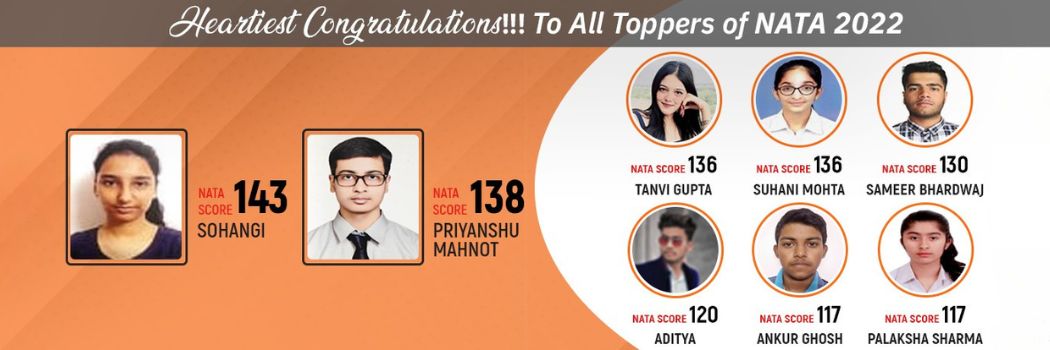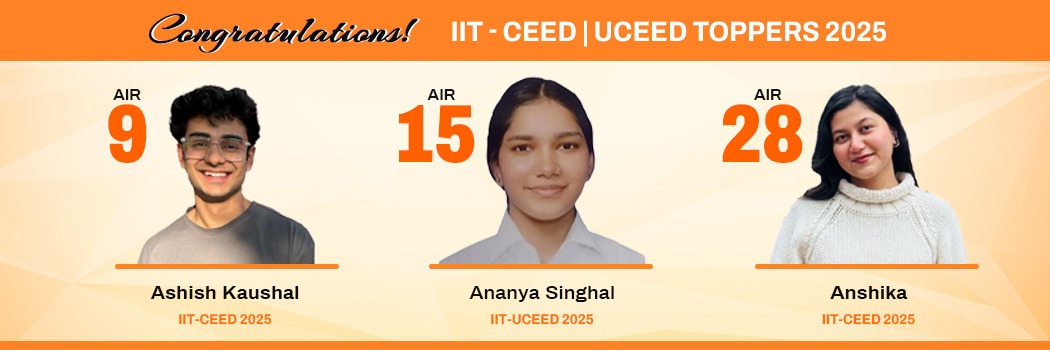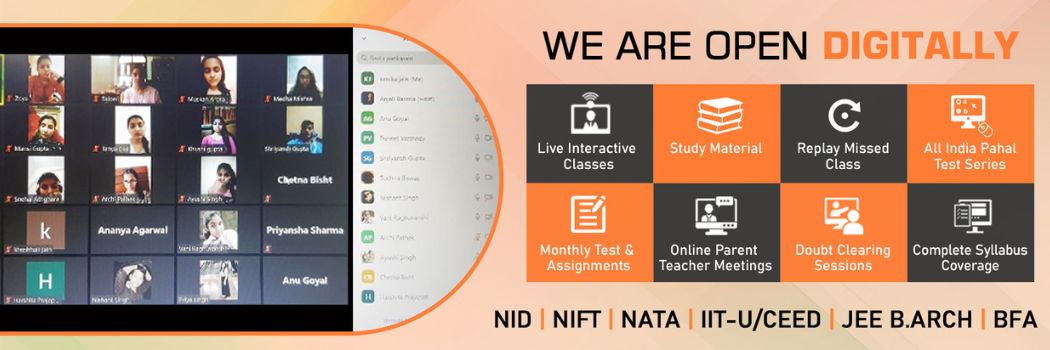National Aptitude Test in Architecture | Your Gateway to Architecture Excellence
The National Aptitude Test in Architecture (NATA) is a national-level entrance examination conducted by the Council of Architecture (COA) for students aspiring to pursue a Bachelor of Architecture (B.Arch) degree from recognized institutions across India.
NATA assesses the drawing and observation skills, sense of proportion, aesthetic sensitivity, and critical thinking ability of candidates in the field of architecture.
Council of Architecture (COA), established under the Architects Act, 1972, is the statutory body responsible for conducting NATA examination.
NATA scores are accepted by 400+ architecture colleges across India for admission to first-year B.Arch programs.
NATA is conducted in a hybrid mode: Part A (Mathematics & General Aptitude) is computer-based, while Part B (Drawing Test) is conducted on paper.
There is no age limit for appearing in NATA 2026. Candidates of any age group can apply if they meet the academic qualifications.
Candidates can appear for NATA multiple times in different years. There is no restriction on the number of attempts. Two tests are conducted each year.
| Component | Type | Questions | Marks | Duration |
|---|---|---|---|---|
| Part A: Mathematics | Computer-based (MCQ) | 20 | 80 | 75 minutes |
| Part A: General Aptitude | Computer-based (MCQ) | 40 | 120 | 75 minutes |
| Part B: Drawing Test | Paper-based (Practical) | 2 | 100 | 90 minutes |
| Total | 62 | 300 | 240 minutes | |
+4 marks for each correct answer
-1 mark for each incorrect answer
0 marks for unattempted questions
+3 marks for each correct answer
-0.75 marks for each incorrect answer
0 marks for unattempted questions
Subjective evaluation based on:
• Proportion & Composition
• Creativity & Originality
• Technical Execution
• Understanding of Space
Drawing of patterns, elevations, 3D understanding of objects, building forms and elements, color texture, harmony and contrast
Visualizing different sides of objects, drawing of geometric & abstract shapes, creating two-dimensional compositions, memory drawing, imaginative compositions
| Event | Tentative Dates (2026) |
|---|---|
| Official Notification Release | December 2025 |
| Online Registration Begins | 1st Week of January 2026 |
| Last Date for Registration | 3rd Week of March 2026 |
| Correction Window Opens | 4th Week of March 2026 |
| Admit Card Release | 1st Week of April 2026 |
| NATA 2026 Test 1 Exam Date | 2nd-3rd Week of April 2026 |
| Answer Key Release | Within 3-4 days of exam |
| Result Declaration | Last Week of April/1st Week of May 2026 |
| Event | Tentative Dates (2026) |
|---|---|
| Registration for Test 2 Opens | 2nd Week of May 2026 |
| Last Date for Registration | 2nd Week of June 2026 |
| Admit Card Release | 3rd Week of June 2026 |
| NATA 2026 Test 2 Exam Date | 1st Week of July 2026 |
| Result Declaration | 3rd Week of July 2026 |
Go to nata.in and click on "Apply Online" link. Read all instructions carefully before proceeding.
Create account with valid email ID and mobile number. Verify through OTP. Generate login credentials.
Enter personal details, academic information, select test city preferences (3 choices), upload required documents.
Recent photograph (passport size), signature, 10th & 12th mark sheets, category certificate (if applicable).
Application fee: ₹1,800 (General/OBC) or ₹900 (SC/ST). Payment via credit/debit card, net banking, or UPI.
Review all details, submit application, download confirmation page, and save for future reference.
| Timeline | Mathematics | General Aptitude | Drawing |
|---|---|---|---|
| Months 6-4 Before Exam | Complete syllabus, chapter-wise practice, concept building | Build awareness, study theory, develop observation skills | Learn basics, practice daily, master perspectives |
| Months 3-2 Before Exam | Intensive problem solving, mock tests, speed practice | Practice MCQs, architectural knowledge, pattern recognition | Advanced techniques, timed practice, diverse compositions |
| Last Month | Full-length tests, revision, weak area focus | Current affairs, famous buildings, quick revision | Mock drawing tests, time management, portfolio review |
| Last Week | Formula revision, previous papers, light practice | Quick notes review, visual exercises | Maintain hand flexibility, practice simple sketches |
Systematic coverage of entire syllabus with expert-designed curriculum, ensuring no topic is missed and all concepts are thoroughly understood.
Learn from experienced faculty who understand NATA pattern, common pitfalls, and effective shortcuts for solving complex problems quickly.
Weekly tests, mock exams, and continuous evaluation help track progress, identify weak areas, and improve performance systematically.
Professional guidance on drawing techniques, perspective, shading, composition, and time management - crucial for scoring high in Part B.
Comprehensive books, practice sheets, previous year papers, and exclusive resources designed specifically for NATA preparation.
Interact with like-minded aspirants, participate in group discussions, learn from others' perspectives, and stay motivated throughout preparation.
Learn effective strategies to complete exam within time limit, prioritize questions, and maximize score in all three sections.
Get individual feedback on your drawings, doubts clarification, customized study plans, and one-on-one mentoring for weak areas.
Established in 1999, Pahal Design has been India's pioneer in architecture and design entrance coaching, shaping thousands of successful architects across the nation.
| Course Name | Duration | Best For | Key Features |
|---|---|---|---|
| Foundation Course | 12 Months | Class 11 Students | Complete syllabus coverage, basics to advanced, regular assessments |
| Target Course | 8-9 Months | Class 12 Students | Intensive preparation, focus on exam pattern, speed building |
| Crash Course | 3-4 Months | Last minute prep | Rapid revision, mock tests, exam strategies, important topics |
| Fast Track Course | 2 Months | 2nd Attempt / Revision | Quick recap, drawing intensive, full-length tests |
| Weekend Batch | 6-8 Months | School students | Sat-Sun classes, balanced schedule, regular practice |
| Online Course | Flexible | Distance learners | Live classes, recorded lectures, online tests, doubt sessions |
With 15 centers across major cities, Pahal Design brings quality NATA coaching closer to aspiring architects nationwide.




"Pahal Design's structured approach and excellent drawing faculty helped me score 168 in NATA 2024. The daily drawing practice sessions and personal attention made all the difference. I'm now pursuing B.Arch from SPA Delhi!"
"I was weak in mathematics, but the faculty at Pahal Design Jaipur center made every concept crystal clear. The mock tests prepared me perfectly for the actual exam. Scored 145 and got admission in NIT Trichy. Thank you Pahal!"
"Online classes at Pahal Design were as effective as classroom coaching. Live doubt sessions, recorded lectures for revision, and weekly drawing assignments kept me on track. Successfully cleared NATA with 156 marks!"
95%+
Students qualifying NATA every year
130+
Average NATA score of our students
170+
Multiple students scoring above 170
10,000+
Successful architects created
| College Name | Location | Typical Cut-off |
|---|---|---|
| School of Planning & Architecture (SPA) | Delhi | 150-165+ |
| School of Planning & Architecture (SPA) | Bhopal | 135-150 |
| School of Planning & Architecture (SPA) | Vijayawada | 125-140 |
| NIT Trichy | Tiruchirappalli | 140-155 |
| NIT Calicut | Kozhikode | 135-150 |
| NIT Hamirpur | Hamirpur | 125-140 |
| Jamia Millia Islamia | New Delhi | 130-145 |
| Aligarh Muslim University | Aligarh | 120-135 |
| College Name | Location | Typical Cut-off |
|---|---|---|
| CEPT University | Ahmedabad | 140-160 |
| RV College of Architecture | Bangalore | 120-140 |
| MS University | Baroda | 115-130 |
| Sushant School of Art & Architecture | Gurgaon | 110-125 |
| Amity School of Architecture | Noida | 105-120 |
| Pearl Academy | Delhi/Mumbai | 100-115 |
Join Pahal Design and transform your NATA preparation with India's most trusted coaching institute
Yes, students appearing in Class 12 examinations can apply for NATA 2026. However, admission will be subject to qualifying Class 12 with required marks.
There is no limit on the number of attempts. You can appear for NATA multiple times in different years. Two tests are conducted each year, and you can take both.
Yes, as per Council of Architecture (COA) regulations, NATA is mandatory for admission to any B.Arch program in India, whether government or private college.
A score of 120+ is considered good, 140+ is excellent for top colleges like SPA and NITs, and 100+ opens admission to many decent architecture colleges.
Yes, you can appear for both. Many colleges accept either NATA or JEE Main Paper 2 scores. Taking both increases your admission chances.
Ideally, 6-12 months of structured preparation is recommended. However, with intensive coaching, 3-4 months can also be sufficient if you’re disciplined.
No prior drawing experience is required. We teach everything from basics to advanced level. Our expert faculty will develop your drawing skills from scratch.
Yes, Pahal Design’s online classes are highly interactive with live sessions, doubt clearing, drawing assignments, and regular assessments – equally effective as classroom coaching.
| COLLEGES | LAST DATE | EXAM DATE | FORM COST |
| NIDClosed | 3rd Dec 2024 | 5th Jan 2025 | Rs.3000 |
| NIFTClosed | Admission Closed | Rs.2000 | |
| IIT-UCEED Closed | Closed | Rs.3600 | |
| IIT-CEED Closed | Closed | Rs.2600 | |
| IM,Mumbai APPLY NOW | Admission Open | ||
| WUD,Sonepat APPLY NOW | Admission Open | Rs.1000 | |
| Manav Rachna (MRIIRS),Faridabad APPLY NOW | Admission Open | Rs.1200 | |
| CMRU UniversityAPPLY NOW | Admission Open | Rs.1000 | |
| Rishihood University APPLY NOW | Admission Open | Rs.1000 | |
| Pune Design School, PCU APPLY NOW | Admission Open | Rs.1000 | |
| MIT ID Pune APPLY NOW | Admission Open | Rs.3000 | |
| IMS DIA, NoidaAPPLY NOW | Admission Open | Rs.1200 | |
| WWI, MumbaiAPPLY NOW | Admission Open | Rs.3000 | |
| Sushant University, GurugramAPPLY NOW | Admission Open | Rs.1500 | |
| Chitkara University, ChandigarhAPPLY NOW | Admission Open | Rs.1100 | |
| Lisaa School of Design, BengaluruAPPLY NOW | Admission Open | Rs.1000 | |
| Presidency University, BengaluruAPPLY NOW | Admission Open | Rs.500 | |
| KR Mangalam UniversityAPPLY NOW | Admission Open | Rs.900 | |
| LPU, PhagwaraAPPLY NOW | Admission Open | Rs.500 | |
| USD,SuratAPPLY NOW | Admission Open | Rs.1500 |
Best NIFT Coaching in Delhi | Best NIFT Coaching in Bangalore | Best NIFT Coaching in Lucknow | Best NIFT Coaching in Ranchi | Best NIFT Coaching in Patna | Best NID Coaching in Delhi | Best NID Coaching in Bangalore | Best NID Coaching in Lucknow | Best NID Coaching in Ranchi | Best NID Coaching in Patna | Best NATA Coaching in Delhi | Best NATA Coaching in Bangalore | Best NATA Coaching in Lucknow | Best NATA Coaching in Ranchi | Best NATA Coaching in Patna | Best NATA Coaching in Pune | NIFT Coaching in Indore | NIFT Coaching in Indore | Best NATA Coaching in Bhopal | Best JEE B.Arch Coaching in Delhi | Best JEE B.Arch Coaching in Bangalore | Best JEE B.Arch Coaching in Lucknow | Best JEE B.Arch Coaching in Ranchi | Best JEE B.Arch Coaching in Patna NATA Coaching in Indore
© 2025 All right reserved by PahalDesign Education Pvt Ltd




